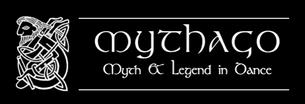Our Tatter Jackets & Masks
Our outfits are a development of the Border Morris tradition, and contain a number of symbols relating to the beliefs of ancient Britain, including the Tree of Life, Sun and Moon.
The Sun represents the warm light of day and the invigorating powers of growth and movement, whilst the Moon represents the cold darkness of night and the restorative powers of rest. Between them is the Tree of Life, which enduring arbor has its roots buried deep in the earth, its branches in the sky, and its trunk in the middle-world of man.
The tatter jackets recall the ribbons and strips of fabric that Border Morris dancers once sewed to their jackets as a form of decoration, and to help to disguise the dancer’s frame. Like many Border sides, our tatter jackets are predominantly black, but they also include elements representing the mythic archetypes of the Sun God and Moon Goddess.

Courtesy of Colin Hart
Mythago Photo Gallery

Courtesy of James Hole

Courtesy of James Hole

Courtesy of James Hole

The Greenmail (Courtesy of James Hole)

The Sun (Courtesy of James Hole)

Courtesy of James Hole

Courtesy of James Hole

The Witch (Courtesy of James Hole)

Courtesy of James Hole

Courtesy of James Hole

Matthew D Crosby Photographics

John Barleycorn (Courtesy of Martin Duffy)

Herne (Courtesy of Martin Duffy)

Herne (Courtesy of Martin Duffy)

Courtesy of David Poole

Courtesy of Paul Murrihy

The Hooden Horse (Courtesy of Martin Duffy)

The Hooden Horse and Horned Hunter

The Wraiths (Courtesy of Martin Duffy)

Courtesy of Martin Duffy

Courtesy of Martin Duffy

The Sun and Moon (Courtesy of Martin Duffy)

The Knucker Dragon (Courtesy of Martin Duffy)
About Our Masks
Our masks contain a number of symbols relating to the beliefs of ancient Britain, including the Tree of Life, Sun and Moon.
The Sun represents the warm light of day and the invigorating powers of growth and movement, whilst the Moon represents the cold darkness of night and the restorative powers of rest
Between them is the Tree of Life, which enduring arbor has its roots buried deep in the earth, its branches in the sky, and its trunk in the middle-world of man.
These symbols are set against the black night sky, evoking the night-time world of dream, within which realm the archetypal characters of our mythic past live on, periodically re-emerging into our waking world through story and song.
The word ‘mask’ itself derives from the Old French mascurer meaning ‘to disguise by blackening the face’, and is related to the Medieval Latin masca meaning ‘mask, spectre, nightmare’ and the Old Occitan masco, meaning ‘witch’.
This custom of using soot or charcoal to disguise the facial contours is referenced in some of the earliest descriptions of border morris and mummers, such as the ‘disguised persons’ or ‘maskers’ who performed at St Mary’s (Shrewsbury) in 1584. Even in 1911, a morris dancer told Cecil Sharp they darkened their face for the purposes of disguise, yet this custom of guising has fallen out of favour in recent years.
This practice of ‘guising’ is associated with many British folk customs, including mummers, pace-egging, Plough Monday celebrations, May Day festivities, chimney sweep festivals, bonfire night, and the Sussex celebrations attendant to St Crispin’s Day. It seems particularly associated with those calendrical customs associated with the long dark nights of winter, being the time of the year when otherworldly spirits roam the earth.
Besides being a nod to disguise and things hidden, black is perhaps the most evocative of all colours, conjuring up notions of our ancient pagan past, eldritch customs, and the strange and mysterious beings haunting the borderlands of night. Within this endless dreamworld of night the shadowy echoes of ancient myth and legend live on. It is a realm of strange and marvellous beasts, great heroes, powerful witches, and mighty kings. Yet, at the in-between times, these shadows take form, their whispers become voice, and the old creatures and figures of mythic Albion once again walk abroad.
And so, through our masked dances, we bring to life the tales of Albion’s mythical past and the many legendary characters inhabiting it, such as the Sun, the Moon, the Earth Mother, the Green Man, the four elements of creation (Earth, Air, Fire and Water), Herne the Hunter, the Spirit of the Corn, the Witch, the King, and the Dragon.
Through story and dance we give form and voice to these mythic figures that live on in the dreamworld of night. In so doing we tap into the old British tradition of masking, wherein those donning the mask blur the line between their own persona and the archetype represented in the mask - the two becoming as one.

Photo Courtesy of James Hole
